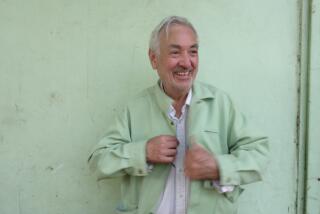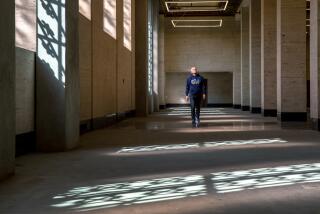Trustees Approve Design for $16.8-Million CSUN Complex
- Share via
NORTHRIDGE — Cal State Northridge, which has sought to fashion a new face since the 1994 earthquake devastated its campus, is about to get a beauty mark.
California State University trustees have approved Robert A. M. Stern’s design for the $16.8-million Arts, Media and Communication building, which is expected to be completed by August 2000.
It will replace the Fine Arts Building, which was designed by Richard Neutra and torn down in 1997 after sustaining heavy earthquake damage. Speaking from his New York office Tuesday, Stern described the new building as a unifier and a catalyst for creative exchange.
“The more people are on the Web, on e-mail, the more faxes are running around the world, the more people are able to accomplish their work at home and deal with their daily lives from there, the more they will need places to come to terms with the inherent reality of human beings,” said Stern, whose high-profile work includes the Disney Feature Animation building in Burbank and the Norman Rockwell Museum in Stockbridge, Mass.
The L-shaped, 80,000-square-foot building will frame the southwestern corner of the campus’ quadrangle and house CSUN’s departments of radio-television-film, communication studies and journalism. An Art and Design Center expansion, recently approved by Cal State trustees, will house the college of art.
Ninety percent of the funds will come from the Federal Emergency Management Agency, the rest from the state Office of Emergency Services. Approval came at last week’s trustees meeting.
*
Barry Rice, associate partner of Robert A.M. Stern Architects, said the glass-dominated building is designed according to new earthquake codes and, therefore, sounder than its predecessor. “The glass is designed to flex and move,” he said, “but not to shatter.”
Critics have said that the understated Fine Arts Building, which was one of Neutra’s last projects, was not among the best examples of his sleek modernist style. Neutra, who has been called the Frank Lloyd Wright of Southern California, is known for sanitized forms of glass, concrete or stucco and straight lines.
“He tried to create a clean, sleek architecture that would look almost light and weightless,” said Paul Goldberger, architecture critic for the New Yorker.
He called Neutra’s buildings a reaction to the heavily ornamented stone and brick designs of the 1920s and 1930s. Eventually, Neutra’s revolutionary style went mainstream, influencing everything from shopping malls to airports and strip malls. Neutra’s supporters call him the father of functionalist and democratic architecture. His detractors call his work stark and inflexible.
Said Philip Handler, dean of the College of the Arts, Media and Communication: “It was a fine building. I was very sorry when it was demolished--I watched it being taken down from my own office.
“But I had questions about its efficiency. It was a maze--finding your way around was complicated.”
If Neutra’s work was a critique of 1920s architecture, Stern’s is a critique of the modernist school.
“Stern thought the modernists threw it all away a little too quickly,” Goldberger said. “Stern reuses history, and now even modernism has become history.”
Said Stern: “We wanted to pick up some of Neutra’s threads.”
But Stephanos D. Polyzoides, a professor, critic and principal of a Los Angeles-based architecture firm, said he worries that the Stern building may be too respectful of Neutra’s style.
“This building is a little too polite for this campus,” said Polyzoides, who is designing CSUN’s new faculty club.
He suggested that something a little jazzier could reinvigorate the campus, which one architect said “looks like a collection of bank buildings.”
Stern defended his work, however, calling it a symbol of optimism and openness.
“How shall I put this delicately? Cal State has a mixed architectural heritage,” said Stern, who was recently appointed dean of Yale University’s School of Architecture. “I’m an architect that’s known for looking around at the context.”
More to Read
Sign up for Essential California
The most important California stories and recommendations in your inbox every morning.
You may occasionally receive promotional content from the Los Angeles Times.










